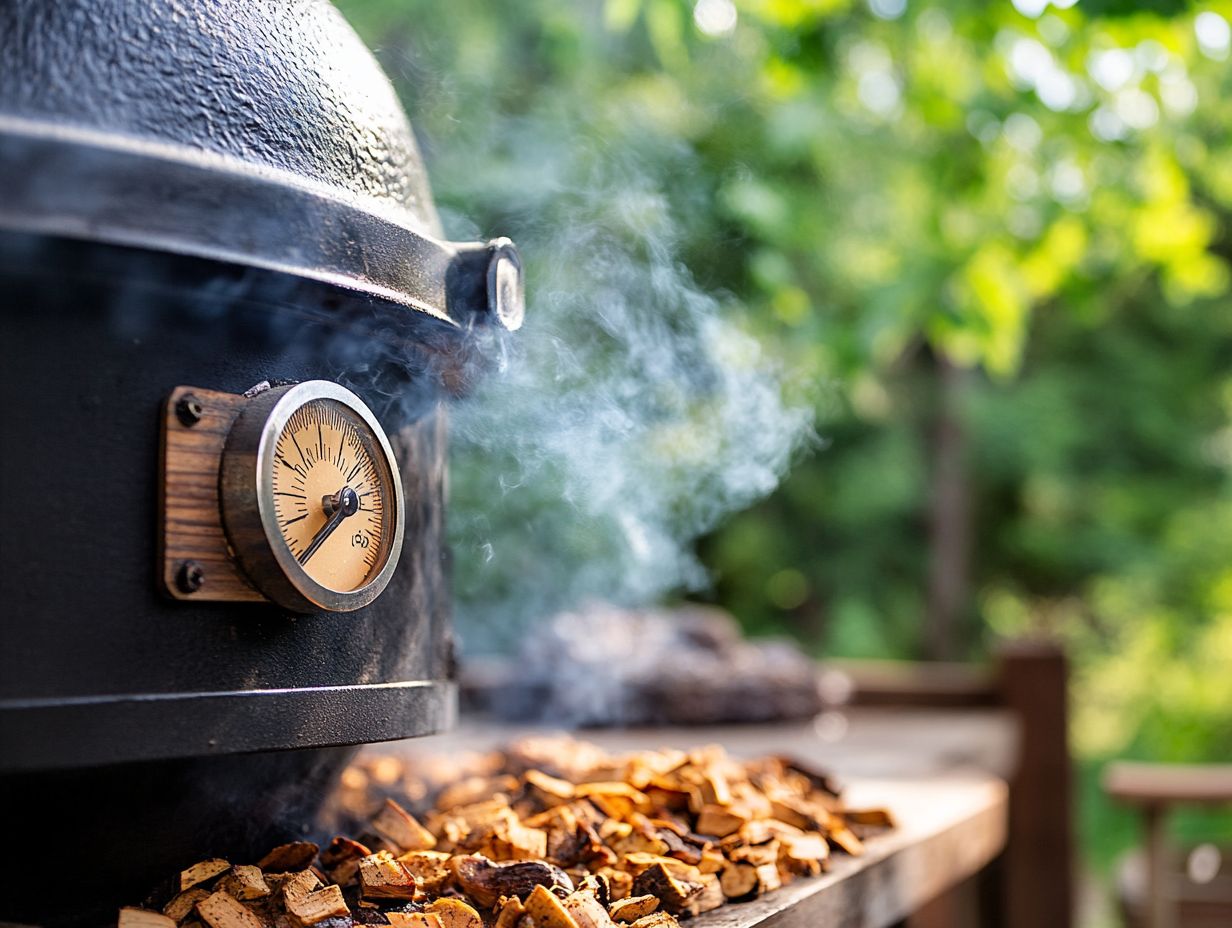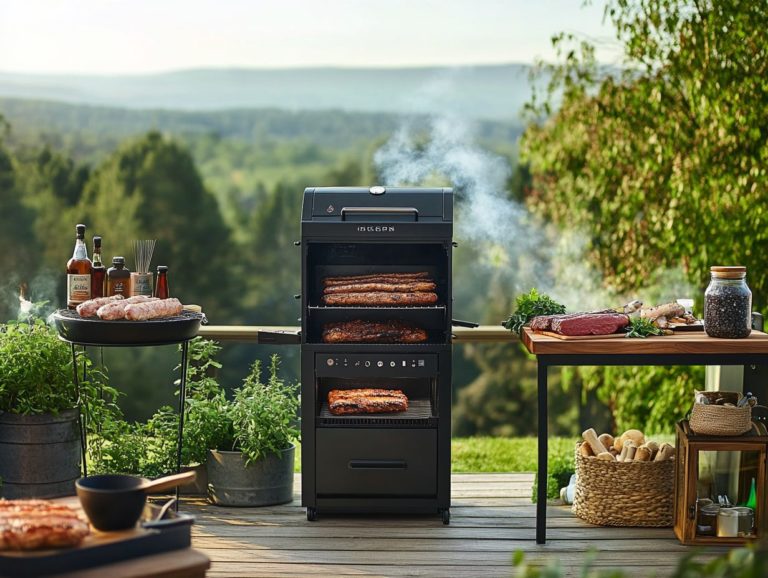Understanding Temperature Control in Your Smoker
Temperature control is key to perfectly smoked meat, especially with a high-quality smoker. Mastering this skill can elevate both novice and seasoned pitmasters alike.
This article covers different types of smokers and their unique temperature control methods. It examines factors that can influence temperature and offers essential tips to help you maintain the ideal cooking environment, including the use of wood chips and water pans.
Get ready to unlock the full potential of your smoking experience!
Contents
- Key Takeaways:
- The Importance of Temperature Control in Smoking
- Types of Smokers and Their Temperature Control Mechanisms
- Factors Affecting Temperature Control in Smoking
- Tips for Achieving Optimal Temperature Control
- Frequently Asked Questions
- What is smoker temperature control?
- Why is temperature control important in smoking food?
- What factors can affect temperature control in a smoker?
- What are some tips for maintaining temperature control in a smoker?
- How can I raise or lower the temperature in my smoker?
- What are the recommended temperature ranges for smoking different types of food?
Key Takeaways:

The Importance of Temperature Control in Smoking
Temperature control is essential in the smoking process. It allows you to cook meat evenly while preserving its juicy flavors. This involves managing your heat source, monitoring temperature fluctuations, and adjusting airflow for consistent results.
Mastering your cooking temperature can significantly enhance the quality of smoked meats, such as brisket, improving their flavor and texture. Smokers like the Big Green Egg and Weber provide various methods to help you reach that perfect temperature.
This discussion will explore the critical role of temperature control in smoking and how it impacts your BBQ results.
Why Temperature Control is Crucial for Perfectly Smoked Meat
Temperature control is vital for achieving perfectly smoked meat, as it directly influences the flavor and consistency of your final product.
Maintaining a consistent cooking temperature is essential to ensure that flavors develop properly. Any fluctuations in heat can lead to uneven cooking, resulting in tough or dry sections. Conversely, the right temperature encourages the marinade and smoke to penetrate deeply, enhancing the overall taste.
Different smoking methods, like hot smoking and cold smoking, come with their own specific temperature preferences. Hot smoking cooks the meat at higher temperatures, while cold smoking infuses flavor without cooking it. These methods also affect the type of wood you use. For example, hickory imparts a robust flavor at higher temperatures, while fruitwoods like apple or cherry offer a sweeter note, revealing distinct flavor dimensions when cooked at a steady heat. Understanding these nuances can help you select the best wood for your smoking process.
Types of Smokers and Their Temperature Control Mechanisms
Explore a variety of smokers like the Big Green Egg and Weber. Each has unique features tailored to your smoking style and cooking needs.
Electric Smokers
Electric smokers utilize digital technology for precise temperature control. This method simplifies the process, making it ideal for beginners and experts alike. Models like the BBQ Guru and Flame Boss 200 elevate temperature management, allowing for consistent cooking results.
This innovative approach removes the uncertainty often associated with traditional smoking techniques, making it a perfect choice whether you’re just starting or aiming for perfection. With models like the ThermoWorks smoker, you gain access to automated features that expertly regulate heat, ensuring that your meat cooks evenly and remains delectably juicy.
The intuitive digital interface simplifies temperature monitoring, allowing you to focus on infusing flavor and managing your airflow rather than fretting over hourly adjustments. Ultimately, these smokers empower you to create gourmet-quality dishes effortlessly, liberating you from the intricacies of manual temperature control while ensuring consistent results.
Charcoal Smokers

Charcoal smokers depend on good control of coals and airflow to manage temperature. They are a favorite among traditionalists.
By mastering airflow with adjustable vents and monitoring oxygen levels, you can create the perfect environment for your meats. This ensures even cooking and rich flavors. Tools like a charcoal chimney starter a tool that helps you light coals quickly are invaluable for reaching the right temperature.
Brands like the Big Green Egg stand out with their unique design. They help maintain consistent heat, giving you the power to experiment with different cooking techniques.
Propane Smokers
Propane smokers use a direct heat source for reliable temperature control. They make outdoor cooking easy and enjoyable.
Effortlessly adjust flame levels to maintain consistent temperatures. This is key to achieving that perfect smoky flavor in a variety of meats, even under changing weather conditions.
Models like the Camp Chef Smoke Vault and the Dyna-Glo Propane Smoker offer impressive capacities. They invite you to experiment with various wood types and infusion methods.
With skillful heat and smoke management, these smokers can produce succulent briskets and tender ribs, ensuring a gratifying experience for both beginners and seasoned pitmasters.
Factors Affecting Temperature Control in Smoking
Several factors influence temperature control while smoking. These include weather conditions, the type of meat, and your chosen smoking method.
Weather Conditions
Weather can greatly affect your temperature control when smoking outdoors. It impacts heat retention and airflow.
Wind, rain, and fluctuating temperatures can challenge even the most experienced smokers. It’s crucial to adapt to these elements to achieve the best results.
For example, strong winds can lead to uneven heat distribution and cool your smoking environment quickly, which may lead to less effective cooking.
To combat these conditions, position your smoker in a sheltered spot, such as behind a windbreak like a fence. If rain threatens, a waterproof cover can be a lifesaver while still allowing airflow.
Investing in a quality thermometer lets you monitor internal temperatures effectively. This enables you to make adjustments when external conditions are not ideal.
Type of Meat and Cut
The type of meat and cut significantly influence the smoking process. They guide you in determining the ideal cooking temperature and duration.
For instance, brisket, with its rich marbling, thrives on low and slow cooking around 225 F for about 12 to 15 hours. This method breaks down tough connective tissues.
Pork shoulders, perfect for pulled pork, also prefer low temperatures but usually require less cooking time, around 10 to 12 hours, depending on size.
For poultry like chickens and turkeys, you’ll need to increase the temperature to around 275 F, reducing cooking time to about 3 to 5 hours.
Each cut influences the smoking parameters and brings its unique flavor profile. Brisket delivers depth, pork adds sweetness, and poultry offers a lighter touch, creating a beautifully balanced smoked meal.
Smoking Method and Time

The smoking method you choose hot smoking or cold smoking and the duration of the process are vital for mastering temperature control and flavor development.
Each technique imparts distinct characteristics to your final product. Hot smoking is the best choice for meats, cooking them while infusing rich flavors, resulting in a juicy texture and deep taste. In contrast, cold smoking enhances aromatic qualities without cooking, perfect for items like cheese or fish.
Timing is critical; maintaining a consistent temperature preserves natural moisture and influences how deeply and complexly the flavors penetrate, leading to optimal results. By grasping these nuances, you can elevate your culinary creations to exceptional smoked dishes.
Tips for Achieving Optimal Temperature Control
Achieving optimal temperature control requires a blend of appropriate tools, such as charcoal chimney starters and temperature probes, refined techniques, and a clear understanding of airflow and fuel levels.
Using Thermometers and Temperature Probes
Using thermometers and temperature probes, like those from ThermoPro or Maverick, is essential for accurately monitoring the cooking temperature during the smoking process. This precision ensures that your meat reaches safe temperatures, effectively eliminating harmful bacteria that could lead to foodborne illnesses.
With the surge in popularity of smoking meats, investing in high-quality thermometers, like the ThermoPro, can significantly enhance your cooking experience. These devices deliver quick and trustworthy readings, letting you focus on creating mouthwatering dishes!
Knowing exactly when a brisket hits that ideal internal temperature can transform a good meal into an extraordinary one, ultimately elevating the quality of your finished dish.
Adjusting Airflow and Fuel Levels
Adjusting airflow and fuel levels is vital for mastering temperature control in smoking, as it directly affects both heat and smoke production. A charcoal chimney starter helps light your lump charcoal efficiently, ensuring a steady fire for optimal results.
By managing airflow through vents and dampers with precision, you can fine-tune your cooking environment, achieving the perfect balance for slow, even cooking. Opening the vents boosts airflow, raising the temperature and igniting combustion, while closing them slows the fire and cools the smoke, giving you control over the process.
Opting for high-quality lump charcoal paired with aromatic wood chips enhances flavors and helps maintain consistent temperatures. Keeping the right fuel levels ensures your smoker operates at peak efficiency, allowing for optimal smoke quality that elevates the final results of your smoked meats.
Don t miss out on the chance to elevate your BBQ skills mastering these techniques is the key to delicious smoked meats!
Managing Flare-Ups and Hot Spots
Managing flare-ups and hot spots is essential for maintaining temperature control during the smoking process. This is especially important when cooking different types of meat.
To master this, consider arranging the coals properly. Distributing the coals evenly and leaving space between them can significantly reduce the risk of sudden flare-ups that might scorch your meat, ensuring a more consistent cooking temperature.
Incorporating a water pan into your setup adds moisture to the cooking environment and helps regulate temperatures by absorbing excess heat.
Keep a close watch on cooking temperatures to prevent hot spots. This approach ensures a consistently delicious outcome with every smoking session. Regularly check and adjust the vents on your smoker to achieve the desired airflow and heat distribution.
Frequently Asked Questions

What is smoker temperature control?
Smoker temperature control refers to regulating the heat inside the smoker to achieve and maintain a specific temperature. This ensures food cooks evenly and reaches the desired level of doneness, delivering the best results for your BBQ.
Why is temperature control important in smoking food?
Temperature control is key to cooking food evenly and thoroughly. It helps prevent undercooked or overcooked food and ensures that the food is safe to eat. Maintaining proper airflow is crucial in this process.
What factors can affect temperature control in a smoker?
Several factors can affect temperature control in a smoker, including the type of smoker, the type and amount of fuel used, the outside temperature, and wind or airflow around the smoker. Proper functioning of the exhaust and intake systems also plays a role.
What are some tips for maintaining temperature control in a smoker?
To maintain temperature control, start with a clean and properly preheated smoker. Use a thermometer to monitor the temperature with a digital device and adjust the air vents or dampers as needed. Avoid opening the smoker frequently to prevent fluctuations in temperature that can affect the overall cooking process.
How can I raise or lower the temperature in my smoker?
To raise the temperature, add more fuel or increase the airflow. To lower the temperature, close the air vents or dampers to reduce the oxygen supply to the fire. You can also remove some fuel or add a pan of water to the smoker for better temperature regulation.
What are the recommended temperature ranges for smoking different types of food?
The recommended temperature ranges for smoking vary by food type. For meats, smoke at temperatures between 225 to 250 degrees Fahrenheit. Vegetables and fruits can be smoked at lower temperatures, between 150 to 200 degrees Fahrenheit. Always check the internal temperature of the food with a temperature probe to ensure it is fully cooked.






